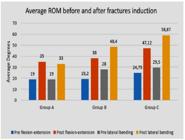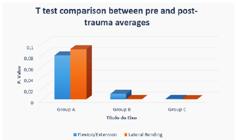ABSTRACT
Traumatic events such as a motor vehicle accident or falling from heights are very common in veterinary medicine and often lead to vertebral fracture-luxation with concomitant spinal cord injuries, mostly in the thoracolumbar spine. The purpose of this cadaveric biomechanical study was to determine the feasibility of the three-column concept in canine thoracolumbar segments with induced fractures. Eighteen Functional Spinal Units (FSU) of the thoracolumbar segments (T12-L2) were collected from 18 medium-sized adult dog cadavers and were subjected to flexion-extension and lateral bending tests so that range of motion (ROM) was recorded with a goniometer. Fractures were induced by compressive loads applied by a universal testing machine (EMIC®). After this, specimens were screened using computed tomography (CT) and the fractures were graded as affecting one, two or three columns, and divided into groups A, B, and C, respectively. Post-fracture range of motion (ROM) was compared with the previous results. Groups B and C (with fractures in two or three columns) had instability in the two axes evaluated (P<0.05). The outcomes of this study support the applicability of the three-column theory to thoracolumbar spines of dogs, as the FSUs that suffered fractures in two or more columns showed axial instability.
Keywords:
dogs; neurology; spinal cord; luxation; spinal fracture

 Thumbnail
Thumbnail
 Thumbnail
Thumbnail
 Thumbnail
Thumbnail
 Thumbnail
Thumbnail
 Thumbnail
Thumbnail
 Thumbnail
Thumbnail





